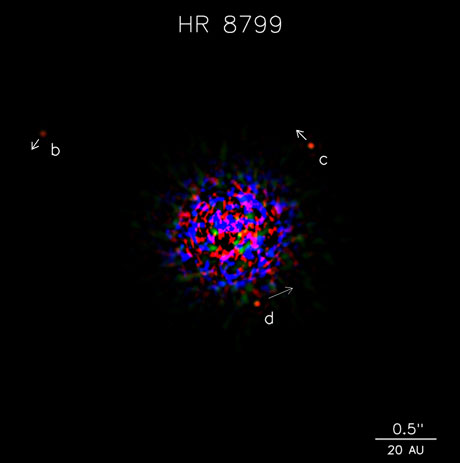Kamuela, HI (November 13th, 2008) Using high-contrast, near-infrared adaptive optics observations with the Keck and Gemini telescopes atop Mauna Kea, astronomers for the first time have taken snapshots of a multi-planet solar system, much like ours, orbiting another star.
The new solar system orbits the dusty young star named HR8799, which is 140 light years away and about 1.5 times the size of our sun. Three planets, roughly 10, 10 and 7 times the mass of Jupiter, orbit the star. The sizes of the planets decrease with distance from the parent star, much like the giant planets do in our system.
And there may be more planets out there that scientists just haven’t seen yet.
“Every extrasolar planet detected so far has been a wobble on a graph. These are the first pictures of an entire system,” said Bruce Macintosh, an astrophysicist from Lawrence Livermore National Laboratory and one of the key authors of a paper appearing in the Nov. 13 issue of Science Express. “We’ve been trying to image planets for eight years with no luck and now we have pictures of three planets at once.”
The team of researchers from Livermore, the NRC Herzberg Institute of Astrophysics in Canada, Lowell Observatory, UCLA, and several other institutions were able to see three orbiting planetary companions to HR 8799. The first author of the paper is Christian Marois, a former Livermore postdoctoral researcher who now works at NRC.
Astronomers have known for a decade through indirect techniques that the sun was not the only star with orbiting planets.
“But we finally have an actual image of an entire system,” Macintosh said. “This is a milestone in the search and characterization of planetary systems around stars.”
During the past 10 years, various planet detection techniques have been used to find more than 200 exoplanets. But these methods all have limitations. Most infer the existence of a planet through its influence on the star that it orbits, but don’t actually tell scientists anything about the planet other than its mass and orbit. Second, the techniques are all limited to small to moderate planet-star separation, usually less than about 5 AU. (Astronomical units; one AU is the average distance from the sun to Earth).
In the new findings, the planets are 24, 37 and 67 times the Earth-sun separation from the host star. The furthest planet in the new system orbits just inside a disk of dusty debris, similar to that produced by the comets of the Kuiper belt of our solar system (just beyond the orbit of Neptune at 30 times Earth-sun distance).
“HR 8799’s dust disk stands out as one of the most massive in orbit around any star within 300 light years of Earth,” said UCLA’S Ben Zuckerman.
In some ways, this planetary system seems to be a scaled-up version of our solar system orbiting a larger and brighter star.
The host star is a bright, blue A-type star, which has been mostly neglected in ground and space-based direct imaging survey since it offers a less favorable contrast between the bright star and faint planet. But they do have an advantage over our sun: early in their life, they can retain heavy disks of planet-making material and therefore form more massive planets at wider separations that are easier to detect. This star is also young – less than 100 million years old – which means its planets are still glowing with heat from their formation.
“Seeing these planets directly – separating their light from the star – lets us study them as individuals, and use spectroscopy to study their properties, like temperature or composition,” Macintosh said.
“Detailed comparison with theoretical model atmospheres confirms that all three planets possess complex atmospheres with dusty clouds partially trapping and re-radiating the escaping heat,” said Lowell Observatory astronomer Travis Barman.
The planets have been extensively studied using adaptive optics on the giant Keck and Gemini telescopes in Hawaii. Adaptive optics enables astronomers to minimize the blurring effects of the Earth’s atmosphere, producing images with unprecedented detail and resolution. LLNL helped build the original adaptive optics system for Keck, the world’s largest optical telescope. Marois developed an advanced computer processing technique that helps to extract the planets from the vastly brighter light of the star.
Keck Observatory Director Taft Armandroff is pleased with this new discovery enabled by adaptive optics. “In 1999, the Keck II telescope became the first large telescope worldwide to develop and install an adaptive optics system. The results have been dramatic. Keck’s adaptive optics systems routinely produce images with significantly greater clarity and detail than those resulting from Hubble Space Telescope. Keck is developing a next generation system that will produce images that are nearly perfectly corrected for atmospheric turbulence at infrared wavelengths, plus it will enable adaptive optics correction at optical wavelengths for the first time and increase the current very narrow fields of view that limit current adaptive optics systems,” Armandroff reported.
“I think there’s a very high probability that there are more planets in the system that we can’t detect yet,” Macintosh said. “One of the things that distinguishes this system from most of the extrasolar planets that are already known is that HR8799 has its giant planets in the outer parts – like our solar system does – and so has ‘room’ for smaller terrestrial planets – far beyond our current ability to see – in the inner parts.”
The W. M. Keck Observatory (www.keckobservatory.org) is operated by the California Association for Research in Astronomy (CARA), a non-profit 501 (c) (3) corporation whose governing board consists of directors from the California Institute of Technology and the University of California. The twin ten-meter telescopes were made possible by grants totaling $138 million from the W. M. Keck Foundation; the Keck I telescope began science observations in 1993, Keck II began in 1996.



